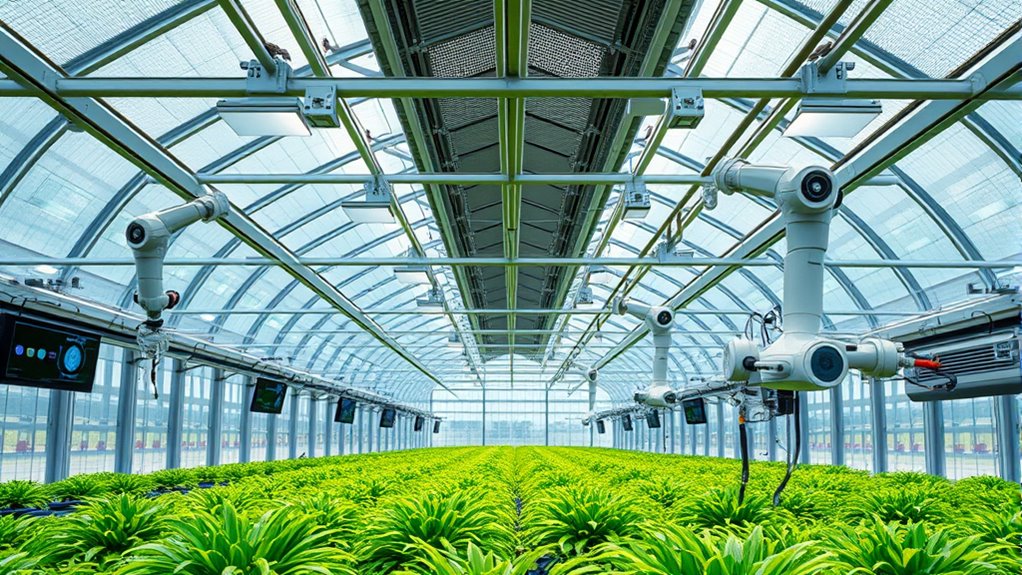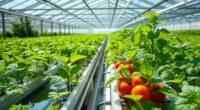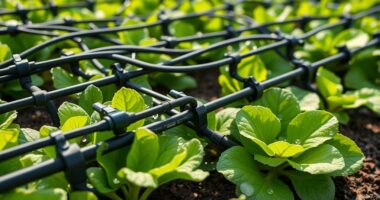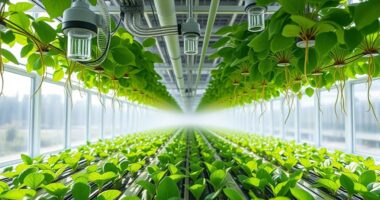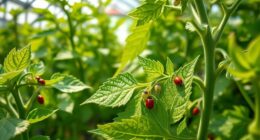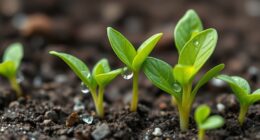To automate your greenhouse, you can implement smart sensors that monitor environmental factors like temperature, humidity, and light, providing real-time data for precise adjustments. Use automated climate control, irrigation, and lighting systems to optimize plant health with minimal manual effort. Integrate IoT devices for seamless communication and data analysis to enhance growth efficiency. Keep exploring these technologies further to discover how they can transform your greenhouse into a smart, sustainable environment.
Key Takeaways
- Integrate IoT sensors for real-time monitoring of environmental variables like temperature, humidity, soil moisture, and light.
- Automate climate control, irrigation, and lighting systems to optimize plant growth and reduce manual intervention.
- Utilize data analytics and predictive algorithms for early pest detection, disease prevention, and environmental adjustments.
- Implement robotic tools for harvesting, pruning, and crop management to increase efficiency and reduce labor costs.
- Incorporate renewable energy sources and future-proof technologies for sustainable, scalable greenhouse automation.
Smart Sensors for Environmental Monitoring

Have you ever wondered how to keep your greenhouse’s environment perfectly balanced? Smart sensors are your answer. They continuously monitor conditions like temperature, humidity, and light, providing real-time data that helps maintain excellent plant health. Integrating sensor technology tailored for horticulture can further optimize the conditions and improve crop yields. These sensors can also assist in data analysis, allowing for more precise adjustments to environmental factors. Modern sensors are designed with safety features, ensuring reliable operation in various conditions and preventing potential malfunctions. With these sensors, you can quickly detect changes that might stress your plants or lead to pests. Early pest detection is vital for preventing infestations and reducing chemical use. These devices alert you immediately if conditions deviate from ideal ranges, so you can take prompt action. Additionally, employing watering tools like self-watering or waterless planters can complement sensor data by maintaining optimal moisture levels with minimal effort. Utilizing air filtration to control pollutants and odors can also help create a healthier environment for your plants.
Automated Climate Control Systems
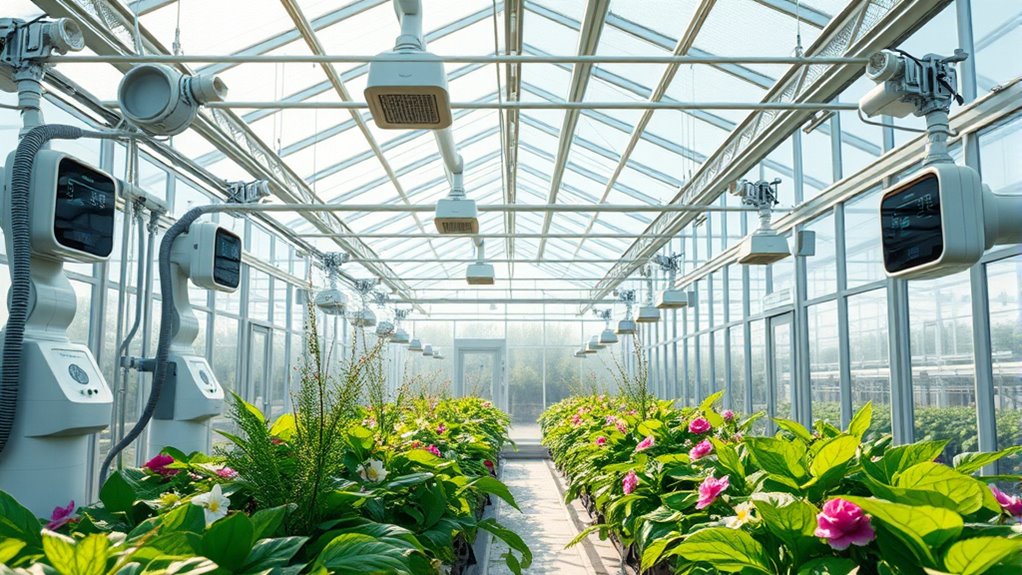
Would you like to simplify managing your greenhouse’s climate? Automated climate control systems make it easy to maintain ideal conditions. These systems adjust temperature, humidity, and ventilation based on sensor data, ensuring your plants thrive. They also support compost management by regulating compost area conditions, preventing odors and pests. Additionally, integrated pest detection sensors alert you to early infestations, allowing swift action.
Simplify greenhouse management with automated systems that optimize temperature, humidity, and ventilation for healthier plants.
Key features include:
- Real-time adjustments for temperature and humidity
- Integration with pest detection systems for early intervention
- Automated ventilation and exhaust controls to prevent mold
- Utilizing sound healing science principles can further enhance plant health by promoting cellular regeneration and overall vitality. Incorporating famous quotes about growth and nurturing can inspire ongoing care and attention to your greenhouse environment.
Irrigation and Watering Automation
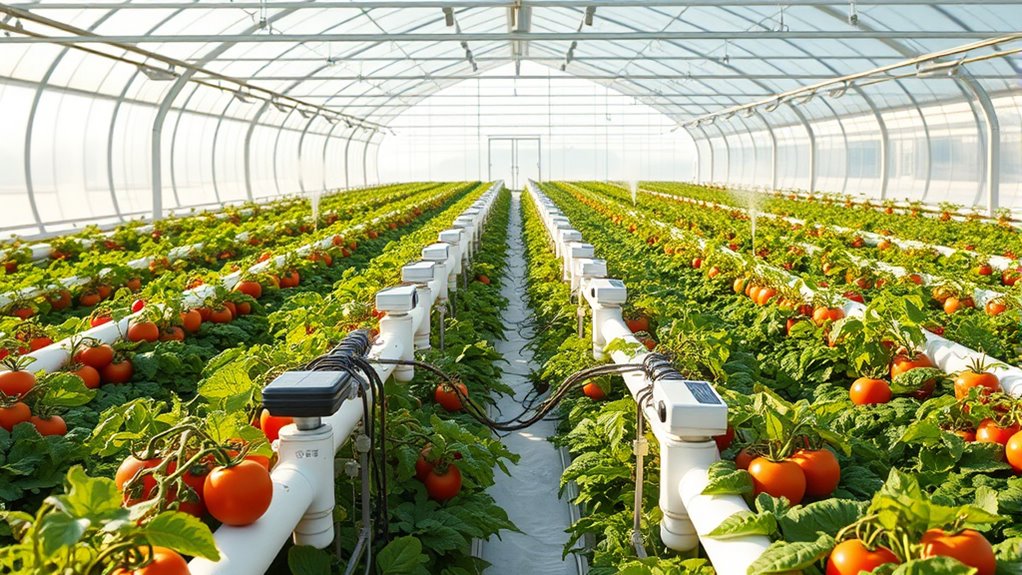
Implementing irrigation and watering automation can considerably enhance your greenhouse management by ensuring your plants receive the right amount of water precisely when they need it. Drip irrigation systems deliver water directly to the roots, reducing waste and promoting healthy growth. Top portable camping options include various models designed for outdoor convenience, many of which feature systems that can be adapted for automated watering setups. Incorporating rain sensors allows your system to detect rainfall and pause watering accordingly, preventing overwatering and conserving water. Automated timers linked to soil moisture sensors can further fine-tune watering schedules, responding dynamically to your plants’ needs. This setup minimizes manual intervention, reduces water bills, and maintains ideal soil conditions. Understanding 19th-century industrial design principles can inspire more efficient and aesthetically pleasing automation setups. Additionally, integrating water-efficient technologies can optimize water use even further. Incorporating suction power and filtration considerations into your system can improve water delivery accuracy and reduce blockages, ensuring consistent watering performance. With these technologies, you gain better control over watering, resulting in healthier plants and more efficient greenhouse operations. Proper automation guarantees your plants thrive, regardless of weather fluctuations outside, and integrating smart irrigation systems can provide even greater precision and efficiency.
Lighting Control Technologies
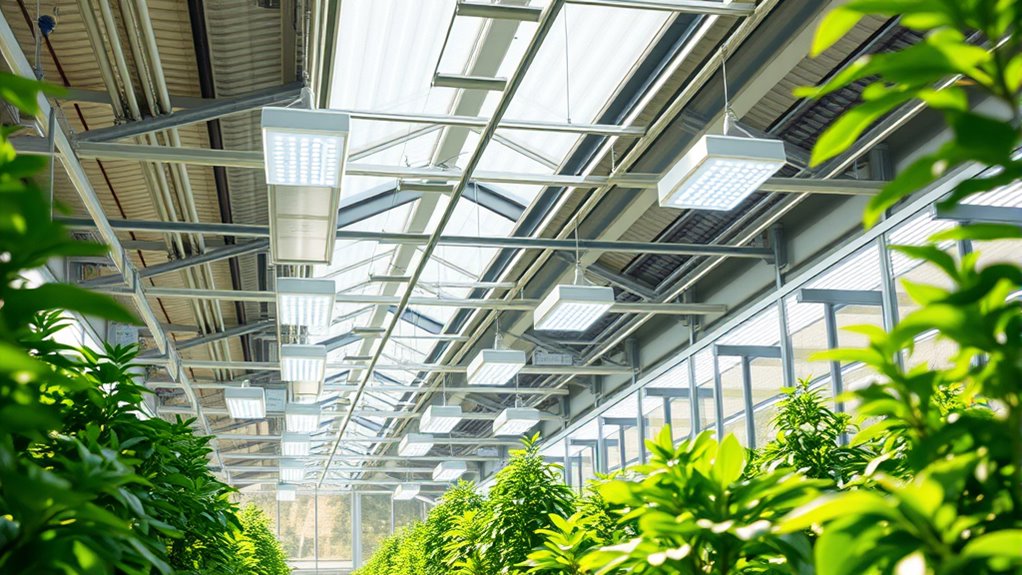
Lighting control technologies enable you to optimize your greenhouse’s light environment, ensuring plants receive the right amount of illumination at the right times. Modern systems often use LED lighting, which offers high LED efficiency and customizable spectrum optimization. This allows for tailored light conditions that can adapt to different plant growth stages, improving overall yield. Additionally, the integration of hybrid tuning principles can further refine lighting schedules for maximum energy efficiency and plant performance. Advanced sound design techniques such as digital sound synthesis can also be employed to monitor and calibrate environmental conditions, creating a more responsive and adaptive system. Proper storage of components and understanding essential oils safety can help maintain the system’s integrity and longevity. Incorporating nutrient absorption insights can enhance the overall effectiveness of your lighting strategies, ensuring plants utilize light energy more efficiently. Furthermore, understanding local laws related to environmental control can help ensure compliance and optimize system operation. Key benefits include:
- Energy savings through precise control of LED lighting, reducing waste.
- Enhanced plant development by adjusting spectrum for different growth stages.
- Automation capabilities that synchronize lighting schedules with natural light, maximizing efficiency.
Integration of IoT Devices in Greenhouses
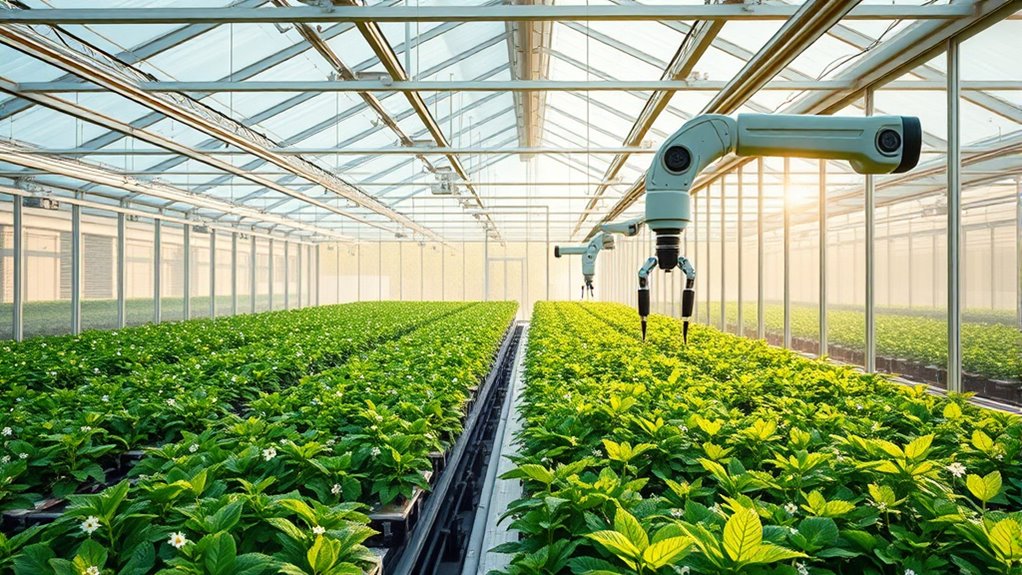
Integrating IoT devices into your greenhouse transforms how you monitor and manage environmental conditions. You’ll connect sensors for temperature, humidity, soil moisture, and light, allowing real-time data collection. Proper sensor calibration guarantees accurate readings, preventing costly mistakes in watering or ventilation. As you set up these devices, prioritize device security to protect your system from cyber threats and unauthorized access. Use strong passwords, encrypt data, and keep firmware updated to safeguard your network. IoT integration automates routine tasks, helping you respond quickly to changing conditions. With seamless communication between sensors and controllers, you gain precise control over your environment. Incorporating industry trends ensures your system remains modern and competitive. This setup enhances plant health, conserves resources, and optimizes growth, making your greenhouse more efficient and sustainable.
Using Data Analytics for Optimal Growth
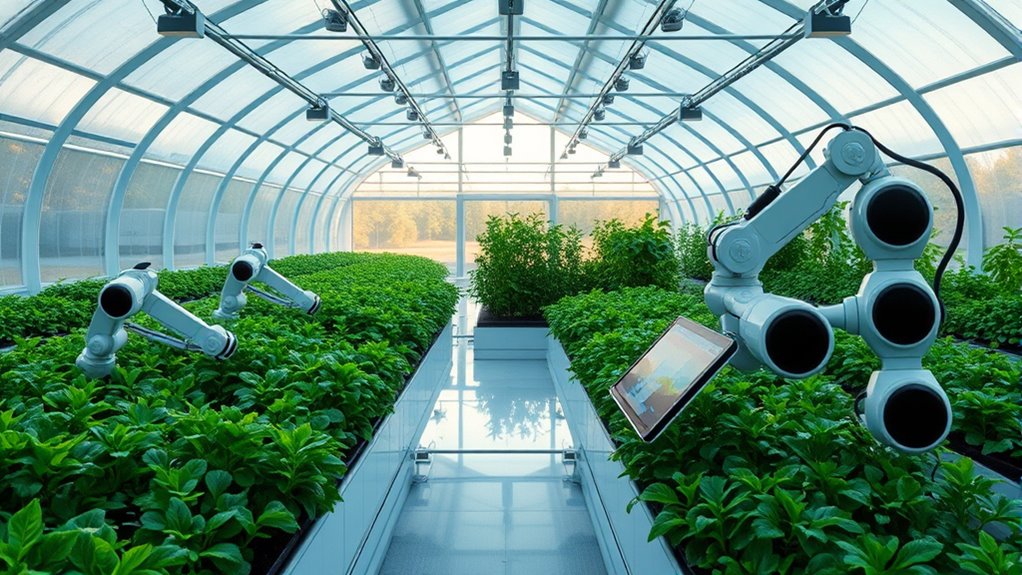
Data analytics unlocks valuable insights from the information collected by your IoT sensors, enabling you to make informed decisions that enhance plant growth. By analyzing data trends, you can identify early signs of crop disease and pest detection, preventing outbreaks before they escalate. This proactive approach improves yield and reduces chemical use. Incorporating nutritional value of juices can also inform nutrient management strategies for healthier plants. To maximize benefits, focus on these key points:
Data analytics reveals early crop issues, boosting yield and reducing chemical reliance.
- Monitor environmental variables like humidity and temperature for ideal conditions.
- Detect early signs of crop disease and pests through pattern analysis.
- Adjust watering, lighting, and nutrient delivery based on real-time data.
- Leveraging data-driven insights allows for precise interventions, optimizing overall plant health and growth efficiency.
Implementing data analytics helps you respond swiftly to potential threats, ensuring healthier plants and higher productivity. It’s a powerful tool for fine-tuning your greenhouse environment and achieving consistent, prime growth outcomes.
Robotic and Automated Harvesting Tools

Robotic and automated harvesting tools are transforming the way you collect crops, increasing efficiency and reducing labor costs. These systems can perform tasks like robotic pruning, which precisely trims plants to promote healthy growth and improve yields.
Automated pollination tools mimic natural processes, ensuring fruits and flowers are fertilized consistently, even in large-scale operations. By integrating sensors and machine vision, these tools identify ripe produce and harvest it with minimal human intervention.
This not only accelerates the harvesting process but also minimizes crop damage. As a result, you save time, lower labor demands, and maintain higher crop quality.
These innovations allow you to scale your greenhouse operation more effectively while ensuring consistent, high-quality yields year-round.
Software Platforms for Greenhouse Management
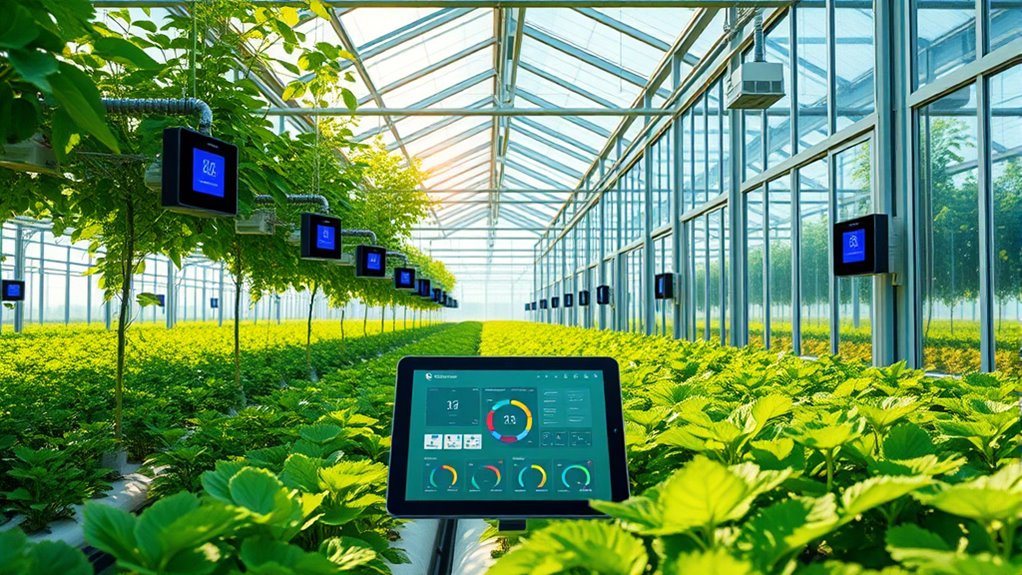
When choosing a software platform, you want an intuitive user interface that makes managing your greenhouse straightforward.
Look for systems with strong data integration capabilities so you can connect sensors, weather data, and your existing tools seamlessly.
Additionally, customizable options let you tailor the platform to fit your specific needs and optimize your growing environment.
User Interface Design
A well-designed user interface is essential for effective greenhouse management, as it directly influences how easily you can monitor and control environmental conditions. An intuitive interface should incorporate features like gesture-based controls, enabling quick adjustments without traditional input devices.
Accessibility features, such as adjustable font sizes and screen readers, make management easier for all users. To optimize usability, focus on these key aspects:
- Clear visual layout that minimizes clutter and highlights critical data
- Gesture controls that facilitate fast, touch-based interactions
- Accessibility options that accommodate diverse user needs
Data Integration Capabilities
Effective data integration is crucial for all-encompassing greenhouse management, as it allows you to seamlessly connect various sensors, climate control systems, and external data sources into a unified platform. A robust software platform ensures your data flows smoothly, enabling real-time decisions.
Prioritize data security to protect sensitive information and maintain system integrity. Look for solutions that support system scalability, so your greenhouse can grow without requiring complete overhauls.
With scalable platforms, you can add new sensors or control modules easily, ensuring your system evolves with your needs. Strong integration capabilities streamline operations, enhance monitoring, and improve overall efficiency.
Choosing the right platform balances security, scalability, and ease of use, giving you confidence in your automation efforts.
Customization Options
Customization options in greenhouse management software empower you to tailor the system to your specific needs, ensuring ideal control and efficiency. You can adjust settings based on your user preferences to optimize workflows and environmental conditions.
This flexibility allows you to focus on what matters most for your greenhouse success. Consider these key features:
- Personal dashboards that display relevant data according to your priorities.
- Custom alerts and notifications, so you’re informed about critical changes.
- Adjustable control parameters for climate, watering, and lighting, aligned with your crop requirements.
Future Trends in Greenhouse Automation
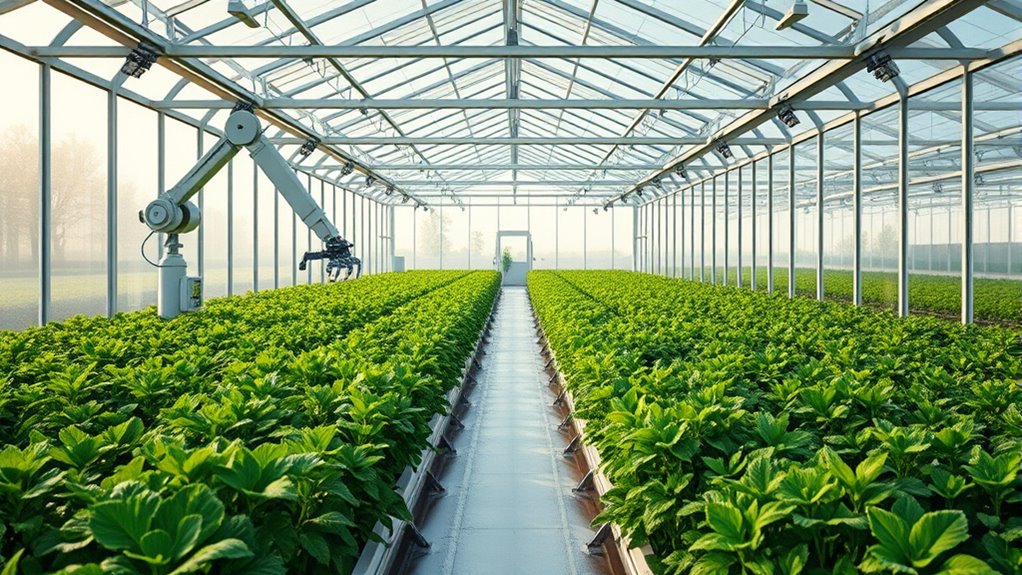
As technology continues to advance, future trends in greenhouse automation are poised to revolutionize how you manage your environment. Expect increased use of biodegradable materials in sensors and structural components, making your setup more eco-friendly.
Renewable energy sources, like solar and wind, will become central to powering automation systems, reducing reliance on grid electricity and lowering your carbon footprint.
Renewable energy like solar and wind will power automation, cutting reliance on the grid and shrinking your carbon footprint.
Smart systems will become more integrated, offering real-time data and predictive analytics to optimize watering, lighting, and climate control automatically.
These innovations will enhance efficiency and sustainability, helping you grow healthier plants with less effort.
As these trends unfold, your greenhouse will become more self-sufficient, eco-conscious, and easier to manage, setting new standards for sustainable agriculture.
Frequently Asked Questions
How Secure Are Iot Devices in Greenhouse Automation Systems?
You wonder about the security of IoT devices in greenhouse automation. While they offer great benefits, they can be vulnerable to cybersecurity threats and hacking attempts.
These devices may have cybersecurity vulnerabilities that expose sensitive data or disrupt operations. It’s crucial to implement strong passwords, regular updates, and secure networks to address data privacy concerns.
Staying vigilant helps protect your system from potential threats and ensures smooth, safe greenhouse management.
What Is the Initial Cost of Implementing Automation Technology?
Think of automation technology as planting seeds for future growth—you need the right investment to start. Your initial costs cover equipment, sensors, and installation, which can vary widely.
While startup costs might seem steep, consider scalability considerations; starting small allows you to expand as your budget grows. Investing wisely now sets the foundation for a thriving, efficient greenhouse that adapts to your needs and future innovations.
How Do Automation Systems Adapt to Changing Weather Conditions?
You can enhance your greenhouse’s efficiency by using automation systems with weather responsiveness and adaptive control. These systems monitor real-time weather data, adjusting heating, ventilation, and watering accordingly.
When conditions change unexpectedly, adaptive control ensures ideal growing environments without manual intervention. This dynamic approach helps protect plants from adverse weather, conserves resources, and maintains consistent conditions.
Ultimately, this boosts productivity and reduces manual oversight.
What Maintenance Is Required for Automated Greenhouse Systems?
You need to regularly maintain your automated greenhouse systems by checking system calibration to guarantee sensors and controls work accurately.
Keep an eye on power management by inspecting electrical connections and backup power sources to prevent outages.
Clean sensors and moving parts to avoid debris buildup.
Also, update software when needed, and perform routine troubleshooting to keep everything running smoothly.
This will help ensure peak plant growth and energy efficiency.
Can Automation Systems Be Customized for Different Crop Types?
You can definitely customize automation systems for different crop types, as this enhances crop-specific customization and boosts productivity. Automation flexibility allows you to adjust watering schedules, lighting, and climate controls tailored to each crop’s needs.
This way, you optimize growth conditions, improve yields, and reduce resource waste. By leveraging adaptable automation, you guarantee your greenhouse is efficiently catering to various crops, making your setup more effective and sustainable.
Conclusion
By embracing these cutting-edge systems, you transform your greenhouse into a symphony of precision and efficiency. Think of automation as your trusted garden conductor, guiding every plant to flourish with harmony. As technology becomes your partner, your green oasis will thrive like never before, turning complexity into effortless growth. Step into the future of gardening—where innovation plants the seeds for abundant success, and your green paradise blossoms with the power of smart automation.
